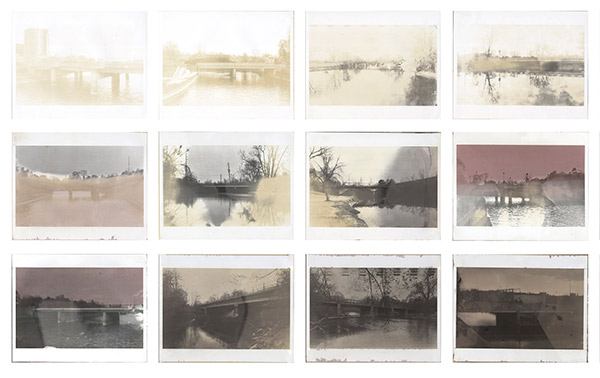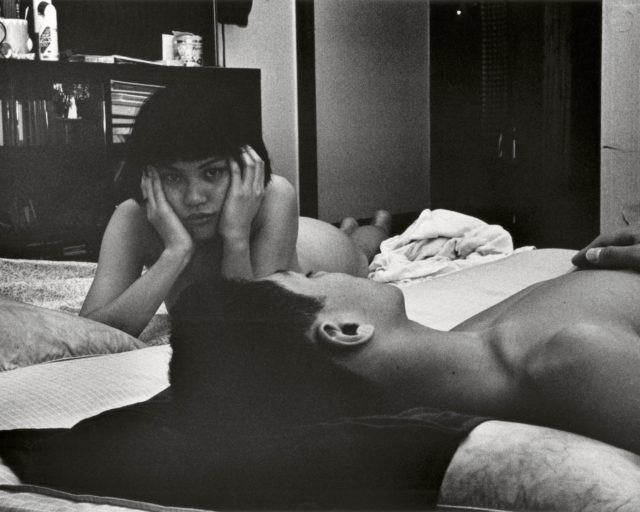Matthew Brandt's Poison Pictures
In his new body of work, the experimental photographer uses Flint’s contaminated tap water to create daring abstractions with a political edge.

Matthew Brandt, Stepping Stone Falls 9 C2M1Y2, from the series Waterfalls, 2016
© the artist and courtesy Yossi Milo Gallery, New York
For Matthew Brandt, the subject of a photograph is more than just a passive element. In three new bodies of work, Brandt returns to his familiar mode of working by making use of unorthodox, but pertinent, materials found on-location to produce politically charged images. The show calls attention to Flint, Michigan, by highlighting the city’s recent State of Emergency, an epidemic of contaminated drinking water, as well as the long-standing effects of the economic recession. Brandt’s experimental approach to photography alludes to the uncertainties that residents of Flint, Michigan grapple with daily.
In the first room, four light boxes cut into the darkness with splashes of cyan, magenta, and yellow. The series, Waterfalls (Stepping Stone Falls) (2016) is vivid and abstract—but legible enough to discern the Brutalist architecture of a Flint River dam. The Flint River plays an integral part at every stage of production: Brandt splices digital image files of the dam into individual CMYK transparencies, which are then exposed in his studio to running waters from the Flint River for several weeks at a time. The river bath forms distinct watermarks that blend together into inky pools of dye, a kaleidoscopic abstraction crafted by the very thing the picture depicts.

Matthew Brandt, Bridges Over Flint (detail), from the series Pictures From Flint, 2016
© the artist and courtesy Yossi Milo Gallery, New York
Twenty-four monochromatic pictures of the bridges in Flint lead visitors into the gallery’s second room. The bridges offer a visual reminder of the lives directly affected by unsafe drinking water. In Pictures from Flint (Bridges over Flint) (2016), each photograph is a humble eight-by-ten-inch gelatin silver print that has been hand toned by a number of peculiar substances—red wine, bleach, and Vitamin C—all added to Flint tap water to accentuate the impurities of what commonly pours from the city’s facets. Sequenced from dark to light, the photographs leave the impression that Flint is slowly fading from view. For its residents, it must feel like, they, too, are barely visible in their struggle for safe drinking water and healthy living conditions.
At the back of the gallery, Brandt takes a sharp turn from his overtly political experiments to something more cosmic and introspective. Four enormous circles hang on the gallery walls like portholes into the universe, revealing dark expanses of night sky speckled with luminous clouds of stars. At first glance, the series Night Skies (2016) appears borrowed from the stellar archives of NASA imagery, but closer inspection reveals a fine texture to these star clusters. The truth is that these are not prints at all, but rather cocaine that has been carefully sprinkled upon black velvet to mimic stars in the night sky.

Matthew Brandt, NGC 3372C, from the series Night Skies, 2016
© the artist and courtesy Yossi Milo Gallery, New York
There’s a certain irony in Matthew Brandt’s use of cocaine. It mimics the toxic water that Flint’s residents have been subjected to. The drug, an expensive and life-threatening indulgence, clashes with the toxicity of Flint’s tap water—also a dangerous substance, but one that has been forced upon lower-income families. Rivers and Sky skirts a fine line between political commentary and brazen experimentation with material and process, which proves to be an effective means of communicating the painful uncertainties that Flint’s residents brave daily.
River and Sky is on view at Yossi Milo Gallery, New York, through January 21, 2017.


























